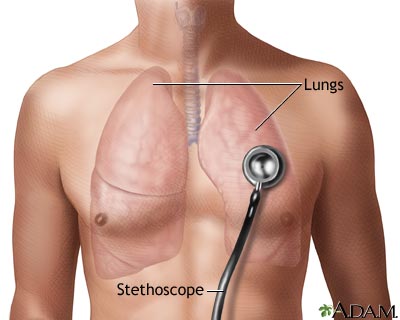Health Topics
Breath sounds are the noises produced by the structures of the lungs during breathing.

Considerations
The lung sounds are best heard with a stethoscope. This is called auscultation.
Normal lung sounds occur in all parts of the chest area, including above the collarbones and at the bottom of the rib cage.

Using a stethoscope, the health care provider may hear normal breathing sounds, decreased or absent breath sounds, and abnormal breath sounds.
Absent or decreased sounds can mean:
- Air or fluid in or around the lungs (such as pneumonia, heart failure, and pleural effusion)
- Increased thickness of the chest wall
- Over-inflation of a part of the lungs (emphysema can cause this)
- Reduced airflow to part of the lungs
There are several types of abnormal breath sounds. The four most common are:
- Rales. Small clicking, bubbling, or rattling sounds in the lungs. They are heard when a person breathes in (inhales). They are believed to occur when air opens closed air spaces. Rales can be further described as moist, dry, fine, and coarse.
- Rhonchi. Sounds that resemble snoring. They occur when air is blocked or air flow becomes rough through the large airways.
- Stridor. Wheeze-like sound heard when a person breathes. Usually it is due to a blockage of airflow in the windpipe (trachea) or in the back of the throat.
- Wheezing. High-pitched sounds produced by narrowed airways. They are most often heard when a person breathes out (exhales). Wheezing and other abnormal sounds can sometimes be heard without a stethoscope.
Causes
Causes of abnormal breath sounds may include:
- Acute bronchitis
- Asthma
- Bronchiectasis
- Chronic bronchitis
- Congestive heart failure
- Emphysema
- Interstitial lung disease
- Foreign body obstruction of the airway
- Pneumonia
- Pulmonary edema
- Tracheobronchitis
When to Contact a Medical Professional
Seek medical care right away if you have:
- Cyanosis (bluish discoloration of the skin)
- Nasal flaring
- Severe trouble breathing or shortness of breath
Contact your provider if you have wheezing or other abnormal breathing sounds.
Your provider will do a physical exam and ask you questions about your medical history and your breathing.
Questions may include:
- When did the breath sound start?
- How long did it last?
- How would you describe your breathing?
- What makes it better or worse?
- What other symptoms do you have?
The provider usually discovers abnormal breath sounds. You may not even notice them.
The following tests may be done:
- Analysis of a sputum sample (sputum culture, sputum Gram stain)
- Blood tests (including an arterial blood gas)
- Chest x-ray
- CT scan of the chest
- Pulmonary function tests
- Pulse oximetry
Alternative Names
Lung sounds; Breathing sounds
Images
References
Ball JW, Dains JE, Flynn JA, Solomon BS, Stewart RW. Chest and lungs. In: Ball JW, Dains JE, Flynn JA, Solomon BS, Stewart RW, eds. Siedel's Guide to Physical Examination. 10th ed. St Louis, MO: Elsevier; 2023:chap 14.
Kraft M. Approach to the patient with respiratory disease. In: Goldman L, Schafer AI, eds. Goldman-Cecil Medicine. 26th ed. Philadelphia, PA: Elsevier ; 2020:chap 77.
Review Date 7/8/2023
Updated by: Linda J. Vorvick, MD, Clinical Professor, Department of Family Medicine, UW Medicine, School of Medicine, University of Washington, Seattle, WA. Also reviewed by David C. Dugdale, MD, Medical Director, Brenda Conaway, Editorial Director, and the A.D.A.M. Editorial team.





